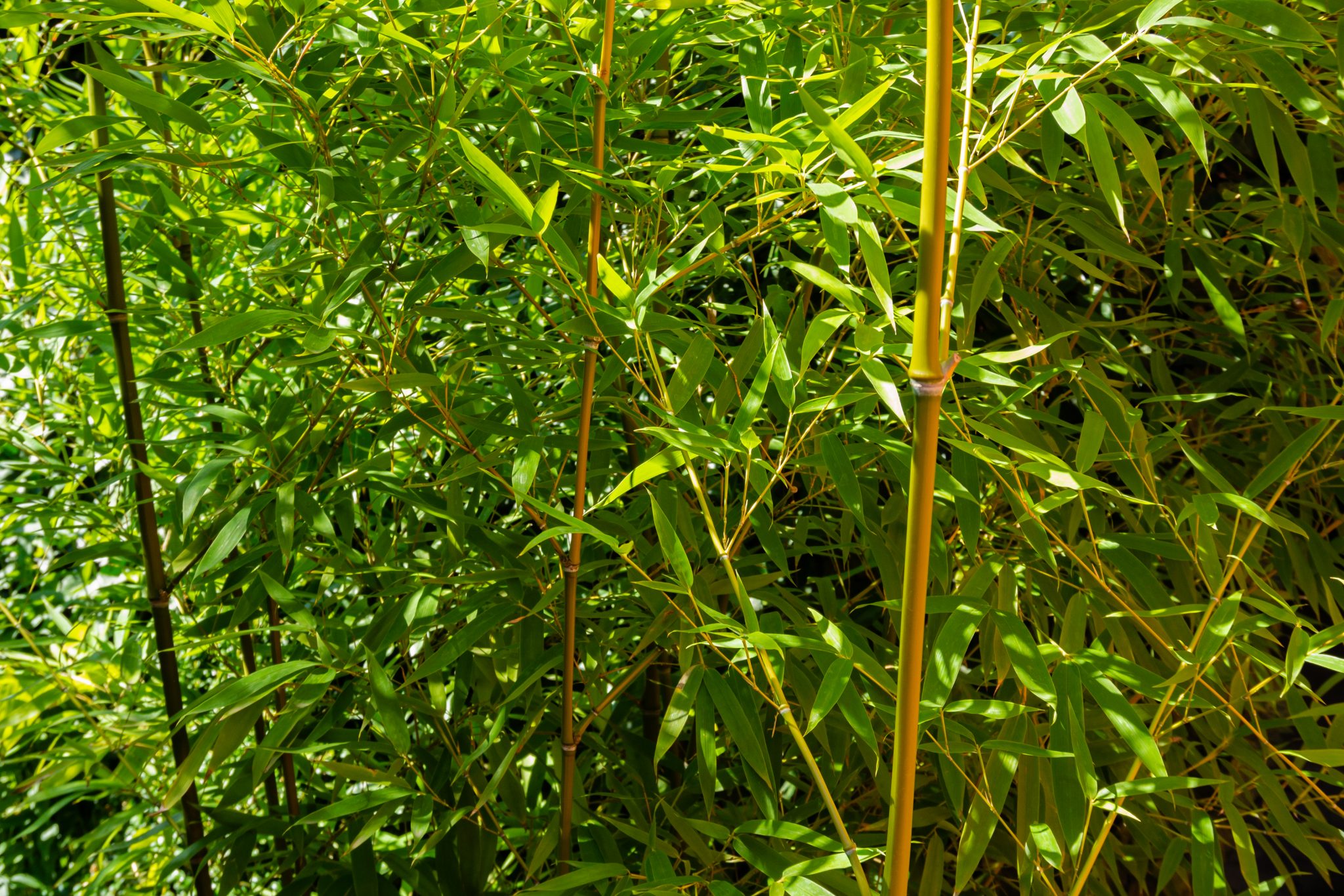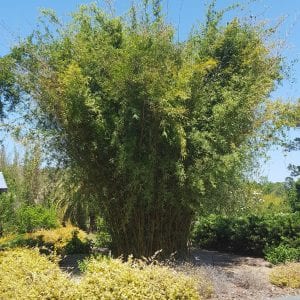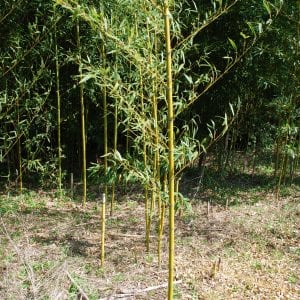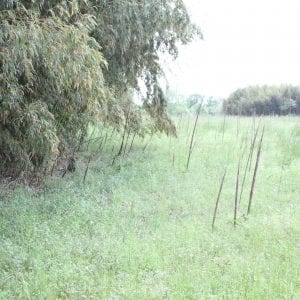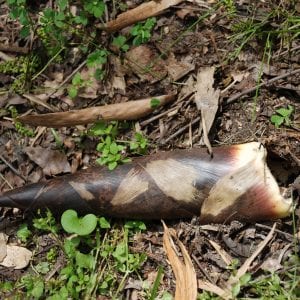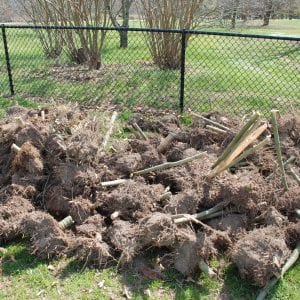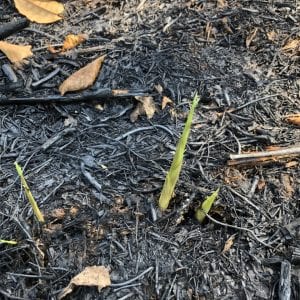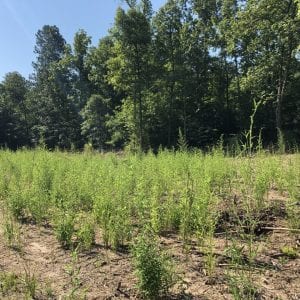Forestry & Wildlife

Many species of bamboo are difficult to control once they’ve become established. Learn options for containment and control.
Golden bamboo (Phyllostachys aurea), historically planted to provide fishing poles, has spread well beyond desired areas in many locations. Sometimes confused with native river canes (Arundinaria spp.), golden bamboo is one of over 1,400 species of fast- growing, woody evergreen grasses in the subfamily Bambusoideae (Poaceae). Bamboos range in size from short ground covers to timber bamboos, which can reach heights of 75 feet and diameters of 5 inches or more.
Several species of non-native bamboo, including golden bamboo, are capable of spreading into forested areas, where they outcompete native plants and provide little wildlife habitat. Once established, bamboo is difficult to control. Understanding how bamboo grows and spreads can help with control efforts.
Bamboo Growth
Bamboo forms groves in which all of the culms (stems) are clones of the original plant. The culms emerge from a dense rhizome system, which usually is located within the upper 12 inches of soil. Rhizomes are modified underground stems that function similarly to roots.
As new culms emerge from the ground, they elongate very rapidly. Individual culms remain the same diameter from emergence to maturity and do not increase in diameter over time. There is, however, an overall increase in the diameter of new culms as a bamboo grove matures. Likewise, an individual culm will not increase in height after the first season, but culms emerging in subsequent years will be taller. Bamboos flower irregularly, sometimes decades apart. Seeding is often followed by death of the grove.
Bamboo categories include the following:
- Clumping bamboos. The rhizomes of clumping bamboos produce very little horizontal growth before they turn upward and produce a culm. As a result, they spread rather slowly, forming dense clumps with minimal spatial spread (figure 1). Most clumping bamboos are from subtropical/tropical regions of Asia, Africa, and South America and are not very cold tolerant. Clumping bamboos are not considered invasive in the Southeast due to their nonspreading growth habit and lack of cold tolerance.
- Running bamboos. The rhizomes of running bamboos produce significantly more horizontal growth and spread, sending up multiple culms along the length of the rhizome (figure 2). Our native river canes are in the running bamboo category. Running bamboos are generally more cold tolerant than clumping bamboos, and many species can grow quite aggressively in the Southeast. Because the rhizome system connects the entire grove, the whole rhizome system must be destroyed to provide complete control of a grove. The large height of many bamboo species also contributes to challenges with control.
- Figure 1. Clumping bamboos have little horizontal spread.
- Figure 2. Running bamboos send up multiple culms along the rhizomes, which can extend many feet beyond the edge of the grove each year.
- Figure 3. New culms emerging in a buffer zone around a grove. During the growing season, the area should be mowed until new culms are no longer emerging. The length of time may be species dependent.
- Figure 4. New culms are fragile and easy to knock or mow over.
Containment Options
Running bamboos require regular management to keep plantings contained. Golden bamboo and other large species can easily spread 15 feet a year. Once bamboo escapes and becomes established it is difficult to eradicate, especially within natural areas and home landscapes.
Buffers
A regularly maintained buffer around groves can prevent spread. Provide a buffer of at least 20 feet around the grove. In the spring while the bamboo is shooting (figure 3), mow or manually remove new culms within the buffer to prevent bamboo from spreading.
Young bamboo culms have a high water content, making them relatively fragile and easy to remove by simply knocking them over (with a kick, shovel, etc.) or cutting with a string trimmer (figure 4). New culms do not emerge at the same time, so mowing or removal must continue until no new shoots emerge. The length of time may depend on the species of bamboo, health and age of the grove, and weather conditions.
Physical Barriers
Belowground physical barriers (such as metal, landscape cloth, or polyethylene sheeting) provide another form of containment. Barriers must be buried to a depth of at least 2 feet to prevent rhizomes from growing underneath the barrier.
Barriers do not stop rhizome growth, but they cause a change in the direction of growth. Angling the barrier outward encourages rhizomes to grow upward where they can be pruned back if they emerge near the edge.
If the barrier is not strong enough, the rhizomes simply will grow straight through. Most barriers eventually will need replacing. Barrier installation guides are available online from bamboo nursery operations, but there is little published research regarding best approaches and materials.
Trenching
A third approach of containment is the use of trenches around the perimeter of a grove. Trenches should be approximately 12 inches wide and as deep as the rhizome mat (1 to 2 feet). Trenches must be monitored periodically so that any bamboo rhizomes emerging into or below the trench can be pruned off. Trenching may provide the most cost-effective long-term containment for many situations.
Control Options
The entire rhizome system must be destroyed to provide complete control on a site. Options include various physical and chemical approaches.
For sites where full control cannot be accomplished (e.g., controlling shoots growing from a neighbor’s planting), containment by trenching is the best long- term option. Healthy, nontreated bamboo connected by rhizomes to a treated area can replenish the energy of rhizomes in the treated area, further hindering control.
When working in bamboo, be aware of starlings that may have roosted in the bamboo. Their droppings may carry several diseases, which could be inhaled if care is not taken.
Physical Control
Hand Pulling
Pulling bamboo by hand or using a weed wrench is not feasible due to the extensive rhizome system.
Cutting and Mowing
Following cutting of the mature culms, repeated cutting or mowing of regrowth over several growing seasons should gradually exhaust belowground reserves. The frequency of cutting and length of time required to achieve control have not been well studied, but control likely depends in some degree on the size, age, and health of the grove. Frequent cutting over the growing season would likely speed up the process.
Smothering
Anecdotal reports suggest that covering an area with a thick tarp following cutting can hinder regrowth and eventually exhaust belowground reserves. Use a rugged tarp that won’t break down in the sun and is thick enough that culms can’t grow through. This approach would be limited to relatively small areas.
Excavation
In areas that can be accessed by heavy equipment and where soil disturbance is acceptable, control can be achieved by excavating the rhizome system (figure 5). Use a backhoe or root rake (or shovel in small areas) to remove all rhizomes. Any rhizomes left in the soil have the potential to resprout. Follow-up monitoring is necessary, as complete removal of the rhizome system may take multiple efforts.
Grazing
All types of livestock will graze on bamboo leaves, but hardened stems will not be eaten. Grazing prescriptions for invasive bamboos have not been well studied. Repeated intensive grazing may help suppress new growth or be considered for control of regrowth following cutting. For large-statured species of bamboo, however, grazing is not likely to provide control as a stand-alone treatment.
Burning
Burning as a stand-alone treatment is not well studied, but it is not likely to be consistently effective. Anecdotal reports indicate that rhizomes resprout rapidly following a fire (figure 6). In addition, controlling a fire in bamboo may be challenging, especially if culms are dry and there is buildup of leaf litter and dead stems in the understory. On the other hand, if culms are widespread and the understory is relatively bare, it may be difficult to get a fire to carry through the grove.
- Figure 5. A pile of excavated bamboo rhizomes. Most rhizomes are located within the top 12 inches of soil.
- Figure 6. Culm regrowth following a fire
- Figure 7. Bamboo regrowth following cutting and disking. Wait for regrowth to reach 3 to 4 feet before applying foliar herbicide treatments.
Chemical Control
In some situations, herbicides may provide the most effective option for control. When using herbicides, always read and follow the label.
Foliar Treatment
Foliar applications of herbicide are most effective when used as a follow-up to cutting once regrowth has reached 3 to 4 feet in height (figure 7). Herbicide options include glyphosate and imazapyr.
With glyphosate, apply a 5 percent solution of a 41 percent ai or higher formulation, using a backpack or high-volume handgun sprayer to achieve full leaf coverage. Complete control likely will require multiple treatments over the course of several years. Homeowners should avoid use of ready-to-use formulations of glyphosate, as the concentration is not high enough to provide good control.
The soil-active herbicide imazapyr also can be used in foliar application but is not recommended or labeled for use in residential areas. Wherever used, care must be taken to avoid damage to any nearby hardwoods.
In other words, do not apply imazapyr anywhere within at least twice the distance of the dripline of valued hardwoods. The recommended rate for foliar treatment of bamboo with imazapyr is 2 percent v/v (using 27 percent ai formulation) or 1 percent (using 54 percent ai formulation).
For broadcast foliar treatments, glyphosate at a rate of 120 ounces per acre (using 41 percent ai formulation or higher) will provide suppression, while imazapyr at 64 or 32 ounces per acre for the 27 and 54 percent ai formulations, respectively, will provide more effective control. A tank mix of glyphosate and imazapyr also can provide effective control.
Keep in mind that these are nonselective treatments that will injure or kill other plants that get sprayed. Also, if working near water, use herbicide formulations labeled for use near water.
Cut Stem Treatments
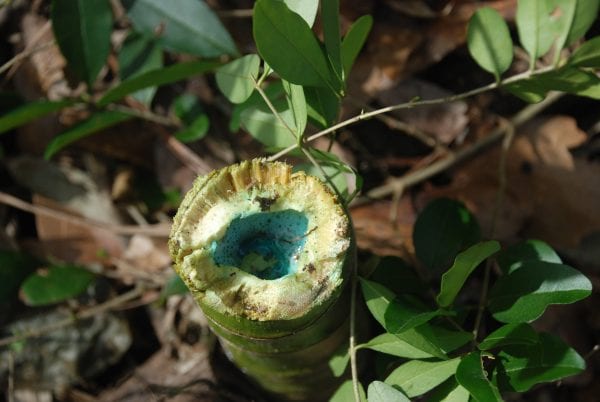
Figure 8. It may be tempting to fill the hollow created when cutting a bamboo culm, but this can lead to overapplication of herbicide.
Cut stump treatments for running bamboos are not well studied. Challenges include the hollow nature of bamboo culms (figure 8) and the extensive rhizome system that must be controlled. The small amount of herbicide applied to the surface of individual stumps might not deliver sufficient chemical amounts to the rhizomes to provide effective control. On the other hand, it may be tempting to fill the hollow area within the stump with herbicide, which could quickly result in exceeding the maximum use rate per acre on the label.
Stem Injection
Stem injection recommendations have been developed for other hollow-stemmed species, such as giant reed (Arundo donax) and Japanese knotweed (Reynoutria japonica), but they have not been tested on running bamboos.
Granular Application
Granular formulations of imazapyr have been observed to control bamboo. However, uniform application in large stands is difficult with ground equipment. This is a nonselective treatment that will injure or kill other plants in the treatment area.
Soil Application
For treatment of extensive infestations in forest situations, hexazinone applied to the soil surface as spots in a grid pattern can provide control. Follow the spacing specified on the herbicide label, using a rate of 2 gallons of herbicide per acre. As with imazapyr, be aware of desirable trees and other adjacent vegetation that could be injured.
Summary
Running bamboos require regular maintenance to prevent unwanted spread. Once they do spread, they can be very difficult to control. In large part, this is because the entire rhizome system must be removed or destroyed in order to provide complete control on a site. For sites where full control cannot be accomplished (e.g. controlling shoots growing from a neighbor’s planting), containment by trenching may be the best long-term option.
Download a PDF of Bamboo Growth and Control, FOR-2088.


